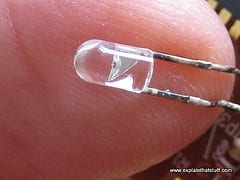The world’s first LED that emits a warm white light
Light emitting diodes, more commonly called LEDs, are known for their energy efficiency and durability, but the bluish, cold light of current white LEDs has precluded their widespread use for indoor lighting.
Now, University of Georgia scientists have fabricated what is thought to be the world’s first LED that emits a warm white light using a single light emitting material, or phosphor, with a single emitting center for illumination. The material is described in detail in the current edition of the Nature Publishing Group journal “Light: Science and Applications.”
“Right now, white LEDs are mainly used in flashlights and in automotive lamps, but they give off a bluish, cool light that people tend to dislike, especially in indoor lighting,” said senior author Zhengwei Pan, an associate professor in the department of physics in the UGA Franklin College of Arts and Sciences and in the College of Engineering. “Our material achieves a warm color temperature while at the same time giving highly accurate color rendition, which is something no single-phosphor-converted LED has ever been shown to do.”
Two main variables are used to assess the quality of artificial light, Pan explained. Correlated color temperature measures the coolness or warmth of a light, and temperatures of less than 4,000 kelvins are ideal for indoor lighting. Correlated color temperatures above 5,000 kelvins, on the other hand, give off the bluish color that white LEDs are known for. The other important measure, color rendition, is the ability of a light source to replicate natural light. A value of more than 80 is ideal for indoor lighting, with lower values resulting in colors that don’t seem true to life.
The material that Pan and his colleagues fabricated meets both thresholds, with a correlated color temperature of less than 4,000 kelvins and a color rendering index of 85.
Warm white light can commonly be achieved with a blue LED chip coated with light emitting materials, or phosphors, of different emitting colors to create what are called phosphor-based white LEDs, Pan said. Combining the source materials in an exact ratio can be difficult and costly, however, and the resulting color often varies because each of the source materials responds differently to temperature variations.
“The use of a single phosphor solves the problem of color stability because the color quality doesn’t change with increasing temperatures,” said lead author Xufan Li, a doctoral student in the College of Engineering.








